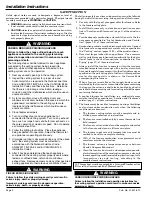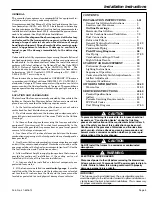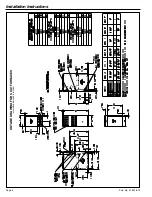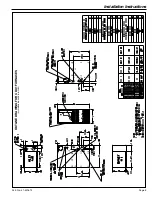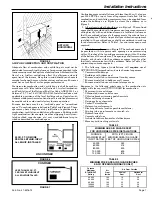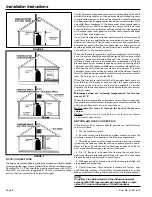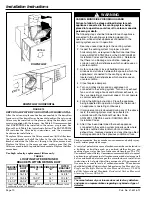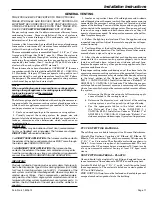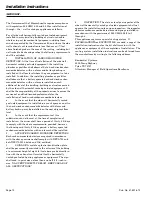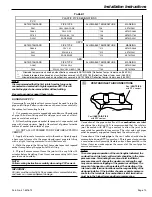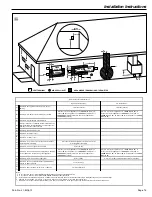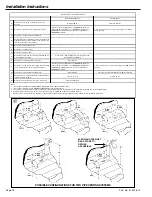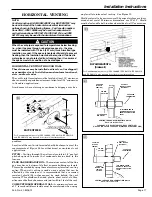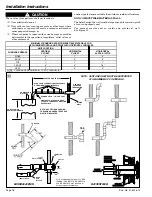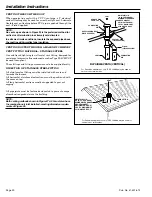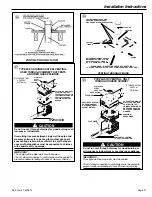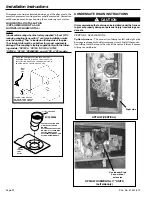
Installation Instructions
Page 7
Pub. No. 41-5016-12
Confined spaces are installations with less than 50 cu. ft. of space
per 1000 BTU/hr. input from all equipment installed. Air for
combustion and ventilation requirements can be supplied from
inside the building as in Figure 8 or from the outdoors, as in
Figure 9.
1. All air from inside the building as in Figure 8: The confined
space shall be provided with two permanent openings communi-
cating directly with an additional room(s) of sufficient volume so
that the combined volume of all spaces meets the criteria for an
unconfined space. The total input of all gas utilization equipment
installed in the combined space shall be considered in making
this determination. Refer to Table 3, for minimum open areas
required.
2. All air from outdoors as in Figure 9: The confined space shall
be provided with two permanent openings, one commencing
within 12 inches of the top and one commencing within 12 inches
of the bottom of the enclosure. The openings shall communicate
directly, or by ducts, with the outdoors or spaces (crawl or attic)
that freely communicate with the outdoors. Refer to Table 3, for
minimum open areas required.
3. The following types of installations will
require
use of
OUTDOOR AIR for combustion, due to chemical exposures:
* Commercial buildings
* Buildings with indoor pool
* Furnaces installed in commercial laundry rooms
* Furnaces installed in hobby or craft rooms
* Furnaces installed near chemical storage areas.
Exposure to the following substances in the combustion air
supply will also require OUTDOOR AIR for combustion:
* Permanent wave solutions
* Chlorinated waxes and cleaners
* Chlorine based swimming pool chemicals
* Water softening chemicals
* Deicing salts or chemicals
* Carbon Tetrachloride
* Halogen type refrigerants
* Cleaning solvents (such as perchloroethylene)
* Printing inks, paint removers, varnish, etc.
* Hydrochloric acid
* Cements and glues
* Antistatic fabric softeners for clothes dryers
* Masonry acid washing materials
AIR FOR COMBUSTION AND VENTILATION
Adequate flow of combustion and ventilating air must not be
obstructed from reaching the furnace. Air openings provided in the
furnace casing must be kept free of obstructions which restrict the
flow of air. Airflow restrictions affect the efficiency and safe
operation of the furnace. Keep this in mind should you choose to
remodel or change the area which contains your furnace. Furnaces
must have a free flow of air for proper performance.
Provisions for combustion and ventilation air shall be made in
accordance with “latest edition” of Section 5.3, Air for Combustion
and Ventilation, of the National Fuel Gas Code, ANSI Z223.1, or
Sections 7.2, 7.3 or 7.4 of CAN/CGA B149 Installation Codes, and
applicable provisions of the local building codes. Special condi-
tions created by mechanical exhausting of air and fireplaces must
be considered to avoid unsatisfactory furnace operation.
Furnace locations may be in “confined space” or “unconfined
space”. Unconfined space is defined in Table 2 and Figure 6. These
spaces may have adequate air by infiltration to provide air for
combustion, ventilation, and dilution of flue gases. Buildings with
tight construction (for example, weather stripping, heavily insu-
lated, caulked, vapor barrier, etc.), may need additional air pro-
vided as described for confined space.
TABLE 2
MINIMUM AREA IN SQUARE FEET
FOR UNCONFINED SPACE INSTALLATIONS
FURNACE
MAXIMUM BTUH
INPUT RATING
WITH 8 FT. CEILING
MINIMUM AREA IN SQUARE
FEET OF UNCONFINED SPACE
40,000
60,000
80,000
100,000
120,000
250
375
500
625
875
MINIMUM FREE AREA IN SQUARE INCHES
EACH OPENING (FURNACE ONLY)
Furnace
Maximum
BTUH/INPUT
Rating
Air
From
Inside
Air From Outside
Vertical
Duct
Horizontal
Duct
40,000
60,000
80,000
100,000
120,000
100
100
100
100
120
10
15
20
25
30
20
30
40
50
60
TABLE 3
FIGURE 6
50 CU. FT. OR MORE
PER 1000 BTU/HR. INPUT
ALL EQUIP. INSTALLED
UNCONFINED
CONFINED
FIGURE 7
LESS THAN 50 CU. FT.
PER 1000 BTU/HR. INPUT
ALL EQUIP INSTALLED
FIGURE 5
UPFLOW/
HORIZONTAL


